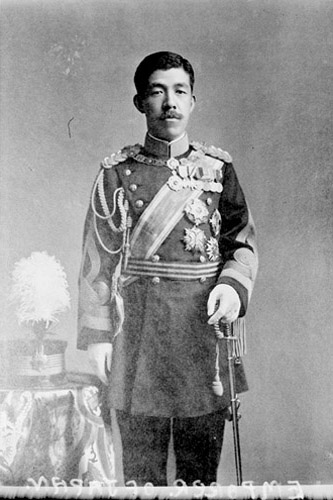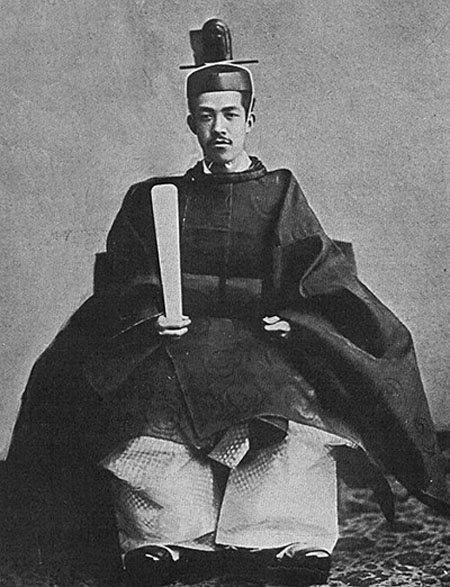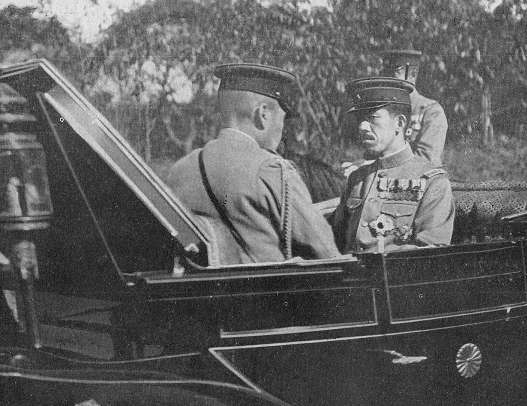<Back to Index>
- Chemist Friedrich Adolf Paneth, 1887
- Author William Saroyan, 1908
- Taishō Emperor of Japan Yoshihito, 1879


The Taishō Emperor (31 August 1879 – 25 December 1926) was the 123rd Emperor of Japan, according to the traditional order of succession, reigning from 30 July 1912, until his death in 1926.
The Emperor’s personal name was Yoshihito. According to Japanese customs, the emperor has no name during his reign and is only called the Emperor. Like all other Japanese emperors, since his death he has been known by a posthumous name that, according to a practice dating back to 1912, is the name of the era coinciding with his reign. Having ruled during the Taishō period (literally Great Righteousness), he is now known as Emperor Taishō. As this is not a personal name, more accurately he should be referred to as "the Taishō emperor". Although outside Japan he is sometimes referred to as Yoshihito or Emperor Yoshihito,
in Japan deceased emperors are referred to only by their posthumous
names. The situation is similar to Popes assuming new names upon taking
office, but additionally the use of a Japanese emperor's personal name
can be considered overly familiar, or even blasphemous. Prince Yoshihito was born at the Aoyama Palace in Tokyo to the Meiji Emperor and Yanagiwara Naruko, a concubine with the official title of gon-no-tenji. As was common practice at the time, the Meiji emperor's consort, Empress Shōken, was officially regarded as his mother. He received the personal name of Yoshihito Shinnō and the title Haru-no-miya from the emperor on 6 September 1879. His two older brothers had died in infancy, and he was also born sickly. Prince Yoshihito contracted cerebral meningitis within three weeks of his birth, leaving him in poor health. (It has also been rumored that he suffered from lead poisoning, supposedly contracted from the lead-based makeup his wet nurse used.) As was the practice at the time, Prince Yoshihito was entrusted to the care of Prince Nakayama Tadayasu [peer], in whose house he lived from infancy until the age of seven. Prince Nakayama had also raised Emperor Meiji as a child. From
March 1885, Prince Yoshihito moved to the Aoyama Detached Palace, where
he was tutored in the mornings on reading, writing, arithmetic, and
morals, and in the afternoons on sports, but progress was slow due to
the Prince’s poor health and frequent fevers. From 1886, he was taught together with 15-20 selected classmates from the ōke and higher ranking kazoku peerage at a special school, the Gogakumonsho, within the Aoyama Palace. Prince Yoshihito was officially declared heir apparent on 31 August 1887, and had his formal investiture as crown prince on 3 November 1888. While crown prince, he was known as Tōgu. In September 1887 the prince entered the elementary department of the Gakushuin,
but due to his health problems he was often unable to continue his
studies. He spent much of his youth by the sea at the Imperial villas at Hayama and Numazu for
health reasons. Although the prince showed skill in some areas, such as
horse riding, he proved to be poor in areas requiring higher-level
thought. He was finally withdrawn from Gakushuin before finishing the
middle school course in 1894. However, he did appear to have an
aptitude for languages and continued to receive extensive tutoring in French, Chinese, and history from private tutors at the Akasaka Palace; Emperor Meiji gave Prince Takehito responsibility for taking care of Prince Yoshihito, and the two princes became friends. From 1898, largely at the insistence of Itō Hirobumi, the Prince began to attend sessions of the House of Peers of the Diet of Japan as
a way of leaning about the political and military concerns of the
country. In the same year, he gave his first official receptions to
foreign diplomats, with whom he was able to shake hands and converse
graciously.
His infatuation for western culture and tendency to sprinkle French
words into his conversations was a source of irritation for Emperor
Meiji. In October 1898, the Prince also traveled from the Numazu Imperial Villa to Kobe, Hiroshima, and Etajima, visiting sites connected with the Imperial Japanese Navy. He made another tour in 1899 to Kyūshū, visiting government offices, schools and factories (such as Yawata Iron and Steel in Fukuoka and the Mitsubishi shipyards in Nagasaki).
On 10 May 1900, Crown Prince Yoshihito married the then 15-year-old Kujō Sadako (the future Empress Teimei), the daughter of Prince Kujō Michitaka, the head of the five senior branches of the Fujiwara clan.
She had been carefully selected by Emperor Meiji for her intelligence,
articulation, and pleasant disposition and dignity – to complement
Prince Yoshihito in the areas where he was lacking. The Akasaka Palace was constructed from 1899 to 1909 in a lavish European rococo style, to serve as the Crown Prince's official residence. The Prince and Princess had the following children: In 1902, the Prince continued his tours to observe the customs and geography of Japan, this time of central Honshū, where he visited the noted Buddhist temple of Zenko-ji in Nagano. With tensions rising between Japan and Russia, the Prince was promoted in 1903 to the rank of colonel in the Imperial Japanese Army and captain in the Imperial Japanese Navy. His military duties were only ceremonial, but he traveled to inspect military facilities in Wakayama, Ehime, Kagawa and Okayama that year. In October 1907, the Crown Prince toured Korea, accompanied by Admiral Tōgō Heihachirō, General Katsura Tarō, and Prince Arisugawa Taruhito. It was the first time the heir apparent to the throne had ever left Japan. In this period, he began studying the Korean language shortly afterwards, although he never became proficient at it. On 30 July 1912, upon the death of his father, Emperor Meiji,
Prince Yoshihito succeeded him on the throne. The new emperor was kept
out of view of the public as much as possible. Having suffered from
various neurological problems throughout his life, by the late 1910s,
these maladies made it increasingly impossible for him to carry out
public functions. On one of the rare occasions he was seen in public,
the 1913 opening of the Diet of Japan, he is famously reported to have
rolled his prepared speech into a telescope and
stared at the assembly through it. Although this is often cited as an
example of his poor mental condition, others believe he may have been
checking to make sure the speech was rolled up properly, as his manual
dexterity was also handicapped. His
lack of articulation and charisma as opposed to Emperor Meiji, his
disabilities and eccentricities led to an increase in incidents of lese-majeste. As his condition deteriorated, he had less and less interest in daily political affairs, and the ability of the genrō, Keeper of the Privy Seal, and Imperial Household Minister to manipulate his decisions came to be a matter of common knowledge. After
1918, he no longer was able to attend Army or Navy maneuvers, appear at
the graduation ceremonies of the military academies, perform the annual Shinto ritual ceremonies or even attend the official opening of sessions of the Diet of Japan. After 1919, he undertook no official duties, and Crown Prince Hirohito was named sesshō (Prince Regent) on 25 November 1921. In early December 1926, it was announced that the emperor had pneumonia. Taishō died of a heart attack at 1:25 a.m. in the early morning of 25 December 1926, at the Hayama Imperial Villa at Hayama, on Sagami Bay south of Tokyo (in Kanagawa Prefecture). Taishō
has been called the first Tokyo emperor because he was the first to
live his entire life in or near Tokyo. Taishō's father was born and
reared in Kyoto; and although he later lived and died in Tokyo, Meiji's
mausoleum is located on the outskirts of Kyoto, near the tombs of his
Imperial forebears; but Taishō's grave is in Tokyo.
Taishō's reclusive life was unaffected by the Great Kantō Earthquake of 1923. Fortuitously, he had moved by royal train to his summer palace at Nikko the
week before the disaster; but his son, the Prince Regent, remained at
the Imperial Palace where he was at the heart of the event. Carrier pigeons kept the emperor informed as information about the extent of the devastation became known.
